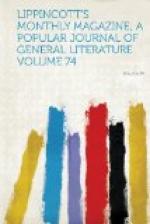Produced by Juliet Sutherland, Christine D and the Online Distributed Proofreading Team at http://www.pgdp.net
Transcriber’s note: Punctuation normalized, original spelling retained.
[Illustration: “He stepped forward with a smile.” For Percival. Page 420.]
Lippincott’s magazine
of
POPULAR LITERATURE AND SCIENCE.
October, 1877.
Vol XX—No. 118
Entered according to Act of Congress, in the year 1877, by J.B. Lippincott & co., in the Office of the Librarian of Congress, at Washington.
CHESTER AND THE DEE.
Two papers.—I.
[Illustration: The Dee above Bala.]
The history of Chester is that of a key. It was the last city that gave up Harold’s unlucky cause and surrendered to William the Conqueror, and the last that fell in the no less unlucky cause of the Stuart king against the Parliamentarians. In much earlier times it was held by the famous Twentieth Legion, the Valens Victrix, as the key of the Roman dominion in the north-west of Britain, and at present it has peculiarities of position, as well as of architecture, which make it unique in England and a lodestone to Americans. Curiously planted on the border of the newest and most bustling manufacturing district in England, close to the coalfields of North Wales, the mines of Lancashire, the quays of its sea-rival Liverpool and the mills of grimy, wealthy Manchester, it still exercises, besides its artistic and historic supremacy, a bona fide ecclesiastical sway over most of these new places. It is the first ancient city accessible to American travellers, many of whom have given practical tokens of their affectionate remembrance of it by largely subscribing to the fund for the restoration of the cathedral, a work that has already cost some eighty thousand pounds.
[Illustration: Caer-gai.]
The neighborhood of Chester is as suggestive of antiquity and foreigners as the city itself. Volumes might be written about the quaint, Dutch-like scenery of the low rich land reclaimed from the sea; the broad, sandy estuary of the Dee, with the square-headed peninsula, the Wirrall, which divides this quiet river from the noisy Mersey; the Hoylake, Parkgate and Neston fisher-folk on the sandy shores, with their queer lives, monotonous scratching-up of mussels and cockles, a never-failing trade, their terms of praise—“the biggest scrat,” for instance, “in all the island,” being the form of commendation for the woman who can with her rake at the end of a long pole scratch up most shellfish in a given time; the low, fertile green pastures, the creamy cheese and the eight yearly cheese-fairs. The city itself is the most foreign-looking in all England, and the




